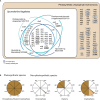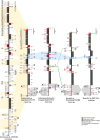Comparative Plastid Genomics of Non-Photosynthetic Chrysophytes: Genome Reduction and Compaction
- PMID: 33013997
- PMCID: PMC7511666
- DOI: 10.3389/fpls.2020.572703
Comparative Plastid Genomics of Non-Photosynthetic Chrysophytes: Genome Reduction and Compaction
Abstract
Spumella-like heterotrophic chrysophytes are important eukaryotic microorganisms that feed on bacteria in aquatic and soil environments. They are characterized by their lack of pigmentation, naked cell surface, and extremely small size. Although Spumella-like chrysophytes have lost their photosynthetic ability, they still possess a leucoplast and retain a plastid genome. We have sequenced the plastid genomes of three non-photosynthetic chrysophytes, Spumella sp. Baeckdong012018B8, Pedospumella sp. Jangsampo120217C5 and Poteriospumella lacustris Yongseonkyo072317C3, and compared them to the previously sequenced plastid genome of "Spumella" sp. NIES-1846 and photosynthetic chrysophytes. We found the plastid genomes of Spumella-like flagellates to be generally conserved with respect to genome structure and housekeeping gene content. We nevertheless also observed lineage-specific gene rearrangements and duplication of partial gene fragments at the boundary of the inverted repeat and single copy regions. Most gene losses correspond to genes for proteins involved in photosynthesis and carbon fixation, except in the case of petF. The newly sequenced plastid genomes range from ~55.7 kbp to ~62.9 kbp in size and share a core set of 45 protein-coding genes, 3 rRNAs, and 32 to 34 tRNAs. Our results provide insight into the evolutionary history of organelle genomes via genome reduction and gene loss related to loss of photosynthesis in chrysophyte evolution.
Keywords: chrysophytes; genome reduction; leucoplast; non-photosynthesis; plastid genome.
Copyright © 2020 Kim, Jeong, Archibald and Shin.
Figures





Similar articles
-
Principles of plastid reductive evolution illuminated by nonphotosynthetic chrysophytes.Proc Natl Acad Sci U S A. 2019 Apr 2;116(14):6914-6923. doi: 10.1073/pnas.1819976116. Epub 2019 Mar 14. Proc Natl Acad Sci U S A. 2019. PMID: 30872488 Free PMC article.
-
Comparative Plastid Genomics of Cryptomonas Species Reveals Fine-Scale Genomic Responses to Loss of Photosynthesis.Genome Biol Evol. 2020 Feb 1;12(2):3926-3937. doi: 10.1093/gbe/evaa001. Genome Biol Evol. 2020. PMID: 31922581 Free PMC article.
-
A new lineage of non-photosynthetic green algae with extreme organellar genomes.BMC Biol. 2022 Mar 17;20(1):66. doi: 10.1186/s12915-022-01263-w. BMC Biol. 2022. PMID: 35296310 Free PMC article.
-
Reductive evolution of chloroplasts in non-photosynthetic plants, algae and protists.Curr Genet. 2018 Apr;64(2):365-387. doi: 10.1007/s00294-017-0761-0. Epub 2017 Oct 12. Curr Genet. 2018. PMID: 29026976 Review.
-
Why are plastid genomes retained in non-photosynthetic organisms?Trends Plant Sci. 2006 Feb;11(2):101-8. doi: 10.1016/j.tplants.2005.12.004. Epub 2006 Jan 9. Trends Plant Sci. 2006. PMID: 16406301 Review.
Cited by
-
Evolutionary Dynamics and Lateral Gene Transfer in Raphidophyceae Plastid Genomes.Front Plant Sci. 2022 May 26;13:896138. doi: 10.3389/fpls.2022.896138. eCollection 2022. Front Plant Sci. 2022. PMID: 35769291 Free PMC article.
-
Gene loss, pseudogenization, and independent genome reduction in non-photosynthetic species of Cryptomonas (Cryptophyceae) revealed by comparative nucleomorph genomics.BMC Biol. 2022 Oct 8;20(1):227. doi: 10.1186/s12915-022-01429-6. BMC Biol. 2022. PMID: 36209116 Free PMC article.
-
A cryptic plastid and a novel mitochondrial plasmid in Leucomyxa plasmidifera gen. and sp. nov. (Ochrophyta) push the frontiers of organellar biology.Open Biol. 2024 Oct;14(10):240022. doi: 10.1098/rsob.240022. Epub 2024 Oct 30. Open Biol. 2024. PMID: 39474867 Free PMC article.
-
Molecular Phylogeny and Taxonomy of the Genus Spumella (Chrysophyceae) Based on Morphological and Molecular Evidence.Front Plant Sci. 2021 Oct 26;12:758067. doi: 10.3389/fpls.2021.758067. eCollection 2021. Front Plant Sci. 2021. PMID: 34764972 Free PMC article.
References
-
- Andersen R. A., Berges J. A., Harrison P. J., Watanabe M. M. (2005). “Appendix A. Recipes for freshwater and seawater media” in Algal culturing techniques. Ed. Andersen R. A. (Elsevier Academic Press; ), 429–538. 10.1016/B978-012088426-1/50027-5 - DOI
-
- Andersen R. A., Graf L., Malakhov Y., Yoon H. S. (2017). Rediscovery of the Ochromonas type species Ochromonas triangulata (Chrysophyceae) from its type locality (Lake Veysove, Donetsk region, Ukraine). Phycologia 56, 591–604. 10.2216/17-15.1 - DOI
-
- Barrett C. F., Freudenstein J. V., Li J., Mayfield-Jones D. R., Perez L., Pires J. C., et al. (2014). Investigating the path of plastid genome degradation in an early-transitional clade of heterotrophic orchids, and implications for heterotrophic angiosperms. Mol. Biol. Evol. 31, 3095–3112. 10.1093/molbev/msu252 - DOI - PubMed
LinkOut - more resources
Full Text Sources

